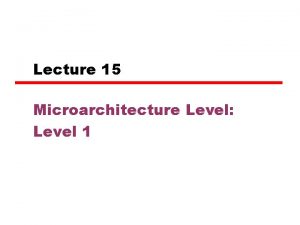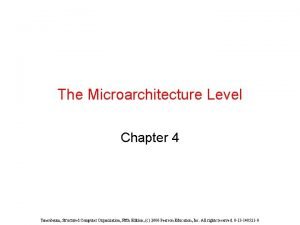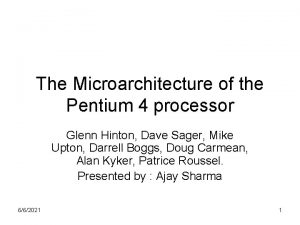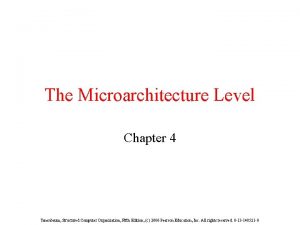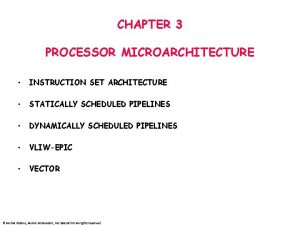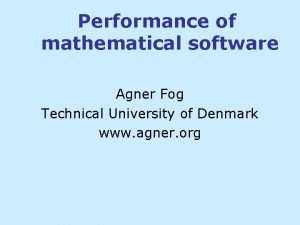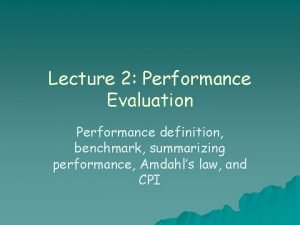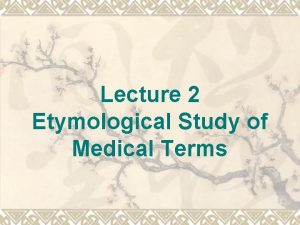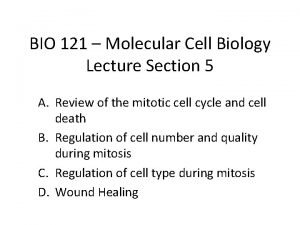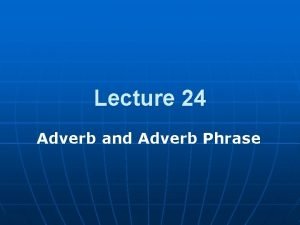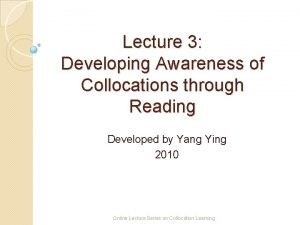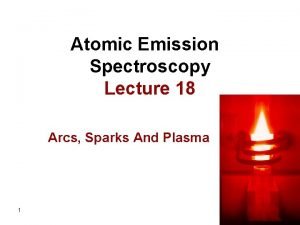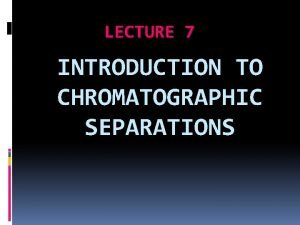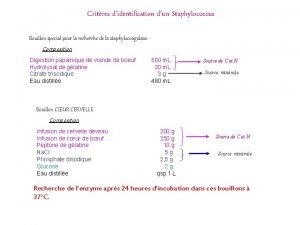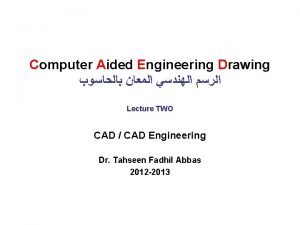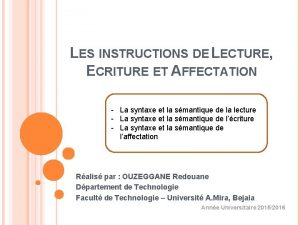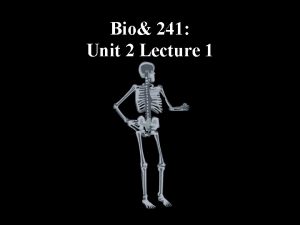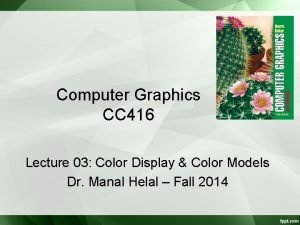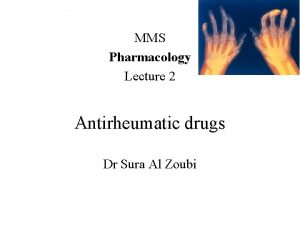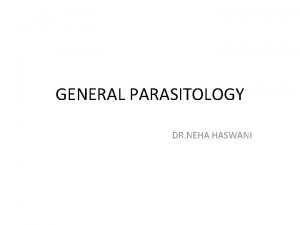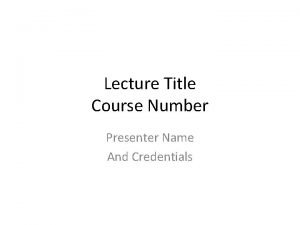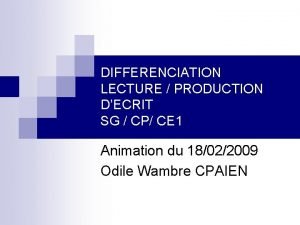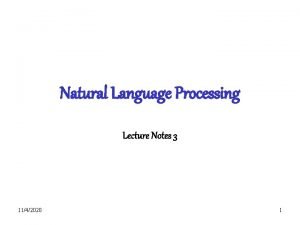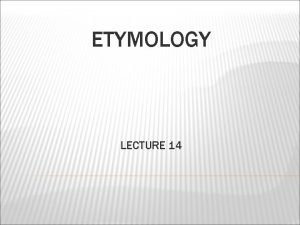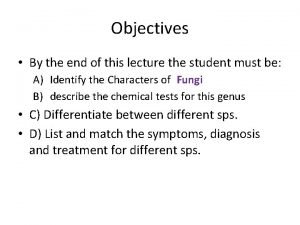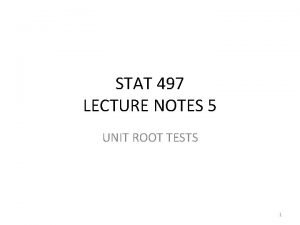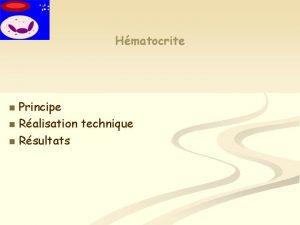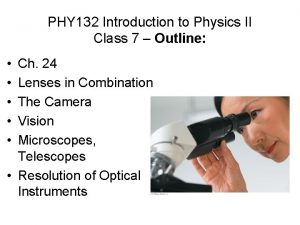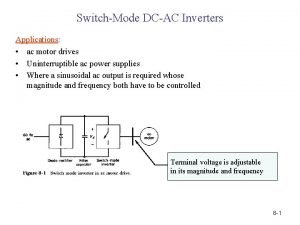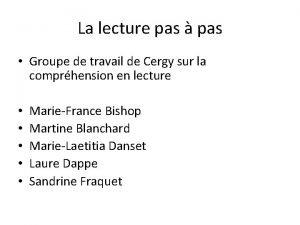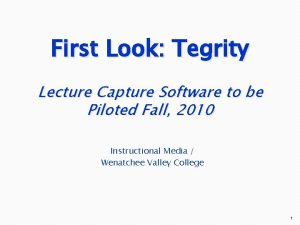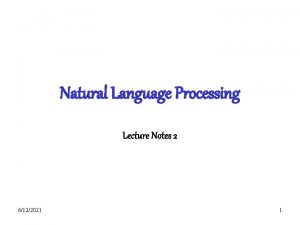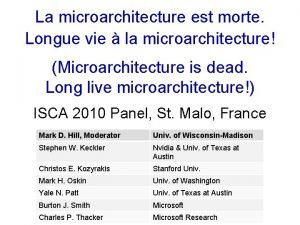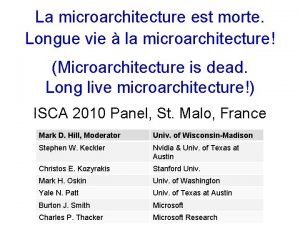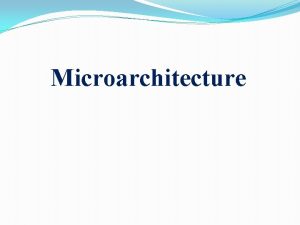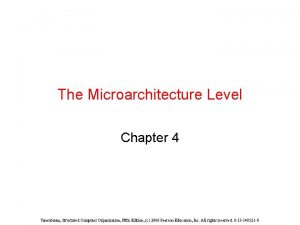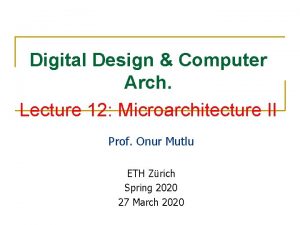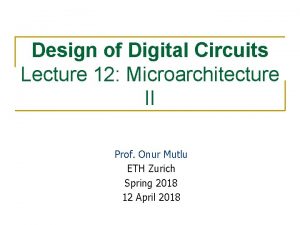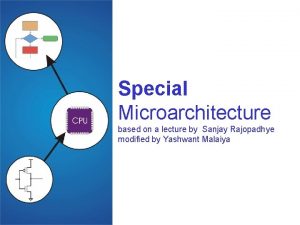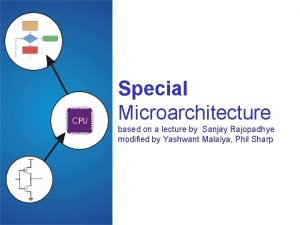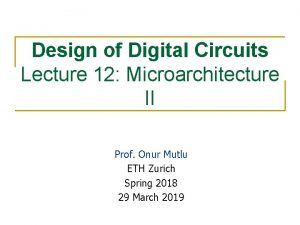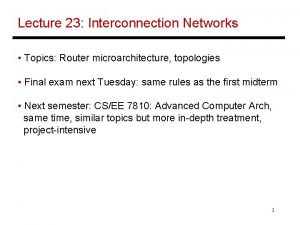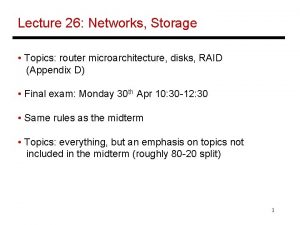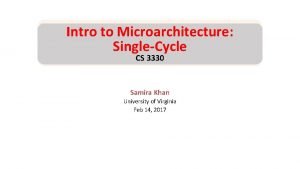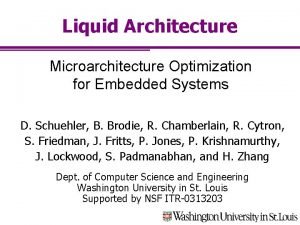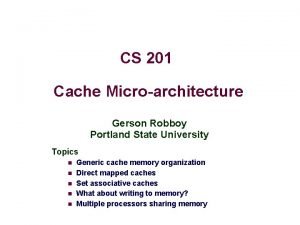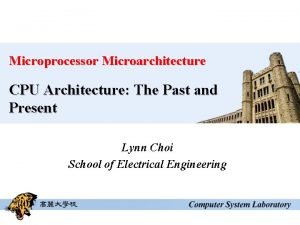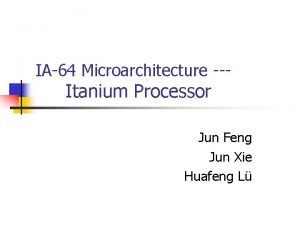Lecture 15 Microarchitecture Level Level 1 Microarchitecture Level























































- Slides: 55

Lecture 15 Microarchitecture Level: Level 1

Microarchitecture Level • The level above digital logic level. • Job: to implement the ISA level above it. • The design depends on: —ISA being implemented —Cost —Performance goal

Microarchitecture Level • Many modern ISAs, e. g. RISC, have simple instructions that can usually be executed in a single clock cycle. • Other complex ISAs, e. g. Pentium IV, may require many clock cycles to execute single instruction.

Basic Elements of Processor • • • ALU Registers Internal data paths External data paths Control Unit

Types of Micro-operation • • Transfer data between registers Transfer data from register to external Transfer data from external to register Perform arithmetic or logical operations

Functions of Control Unit • Sequencing —Causing the CPU to step through a series of micro-operations • Execution —The CU causes each micro-op to be performed. • This is done using Control Signals

Control Signals • Clock —One micro-instruction (or set of parallel microinstructions) per clock cycle • Instruction register —Op-code for current instruction —Determines which micro-instructions are performed • Flags —State of CPU —Results of previous operations • From control bus —Interrupts —Acknowledgements

Model of Control Unit

Control Signals - output • Within CPU —Cause data movement —Activate specific functions • Via control bus —To memory —To I/O modules

Example Control Signal Sequence - Fetch • MAR <- (PC) —Control unit activates signal to open gates between PC and MAR • MBR <- (memory) —Open gates between MAR and address bus —Memory read control signal —Open gates between data bus and MBR

Example: Data Paths and Control Signals

Internal Organization • Usually a single internal bus • Gates control movement of data onto and off the bus • Control signals control data transfer to and from external systems bus • Temporary registers needed for properation of ALU

Microprogrammed Control • A microprogram has a sequence of instructions in a microprogramming language. —These are very simple instructions that specify micro-operations.

Microprogrammed Control • A microprogrammed control unit is a simple logic circuit that is capable of: —Sequencing through microinstructions —Generating control signals to execute each microinstruction. • As in a hardwired control unit, the control signal generated by a microinstruction are used to cause register transfers and ALU operations.

Control Unit Organization

Micro-programmed Control • Use sequences of instructions to control complex operations. • Called micro-programming or firmware

Micro-programmed Control • All the control unit does is generate a set of control signals. • Each control signal is on or off. • Represent each control signal by a bit. • Have a control word for each microoperation. • Have a sequence of control words for each machine code instruction. • Add an address to specify the next microinstruction, depending on conditions.

Micro-programmed Control • Today’s large microprocessor —Many instructions and associated register-level hardware —Many control points to be manipulated • This results in control memory that —Contains a large number of words – co-responding to the number of instructions to be executed —Has a wide word width – Due to the large number of control points to be manipulated

Micro-program Word Length • Based on 3 factors —Maximum number of simultaneous microoperations supported —The way control information is represented or encoded —The way in which the next micro-instruction address is specified

Micro-instruction Types • Each micro-instruction specifies single (or few) micro-operations to be performed — (vertical micro-programming) • Each micro-instruction specifies many different micro-operations to be performed in parallel —(horizontal micro-programming)

Vertical Micro-programming • • Width is narrow n control signals encoded into log 2 n bits Limited ability to express parallelism Considerable encoding of control information requires external memory word decoder to identify the exact control line being manipulated

Horizontal Micro-programming • Wide memory word • High degree of parallel operations possible • Little encoding of control information

Typical Microinstruction Formats

Compromise • Divide control signals into disjoint groups • Implement each group as separate field in memory word • Supports reasonable levels of parallelism without too much complexity

Organization of Control Memory

Control Unit Store a set of microinstructions For vertical microinstructions only

Control Unit Function 1. Sequence logic unit issues read command 2. Word specified in control address register is read (from control memory) into control buffer register 3. Control buffer register contents generates control signals and next address information 4. Sequence logic loads new address into control address register based on next address information from control buffer register and ALU flags

Next Address Decision • Depending on ALU flags and control buffer register —Get next instruction – Add 1 to control address register —Jump to new routine based on jump microinstruction – Load address field of control buffer register into control address register —Jump to machine instruction routine – Load control address register based on opcode in IR

Advantages and Disadvantages of Microprogramming • Advantage: —Simplifies design of control unit – Cheaper – Less error-prone • Disadvantage: —Slower Microprogramming is the dominant technique for implementing control unit in pure CISC.

Hard Wired Control Unit • Disadvantage: —Complex sequencing & micro-operation logic —Difficult to design and test —Inflexible design —Difficult to add new instructions • Advantage: —Faster Hardwired control unit is typically use for implementing control unit in pure RISC.

Tasks Done By Microprogrammed Control Unit • Microinstruction sequencing • Microinstruction execution • Must consider both together

Design Considerations • Size of microinstructions • Address generation time —Determined by instruction register – Once per cycle, after instruction is fetched —Next sequential address – Common in most designed —Branches – Both conditional and unconditional

Sequencing Techniques • Based on current microinstruction, condition flags, contents of IR, control memory address must be generated. • Based on format of address information —Two address fields —Single address field —Variable format

Branch Control Logic: Two Address Fields

Branch Control Logic: Single Address Field

Branch Control Logic: Variable Format

Execution • The cycle is the basic event • Each cycle is made up of two events —Fetch – Determined by generation of microinstruction address —Execute – Effect is to generate control signals – Some control points internal to processor – Rest go to external control bus or other interface

Control Unit Organization

A Taxonomy of Microinstructions • Classification of microinstruction: —Vertical/horizontal —Packed/unpacked —Hard/soft microprogramming —Direct/indirect encoding

How to Encode • K different internal and external control signals • Wilkes’s (first proposed the use of microprogrammed control unit in 1951): —K bits dedicated — 2 K possible combination of control signals. • Not all used —Two sources cannot be gated to same destination —Register cannot be source and destination —Only one pattern presented to ALU at a time —Only one pattern presented to external control bus at a time.

How to Encode • Require Q < 2 K which can be encoded with log 2 Q < K bits • Not done —As difficult to program as pure decoded (Wilkes) scheme. —It is complex and therefore slow control logic module. • Compromises —More bits than necessary are used. —Some combinations that are physically allowable are not possible to encode.

Microinstruction Encoding • In practice, microprogrammed control units are not designed using: —a pure unencoded or —horizontal microinstruction format. • At least some degree of encoding is used to reduce control memory width and to simplify the task of microprogramming.

Specific Encoding Techniques • • Microinstruction organized as set of fields Each field contains code Activates one or more control signals Organize format into independent fields —Field depicts set of actions (pattern of control signals) —Actions from different fields can occur simultaneously • Alternative actions that can be specified by a field are mutually exclusive —Only one action specified for field could occur at a time

Microinstruction Encoding Direct Encoding

Microinstruction Encoding Indirect Encoding

The Data Path: Example The data path is the part of CPU containing ALU, its input and its output. Mic-1

The Data Path: Example( cont…) ALU functions is determined by the 6 control lines. Useful combinations of ALU signals and the function performed.

Microinstruction Control: The Mic-1 • To control the datapath of Mic-1, we need 29 signals: — 9 signal to control writing data from the C bus into registers. — 9 signal to control enabling registers onto the B bus for ALU i/p. — 8 signal to control the ALU and shifter functions. — 2 signal (not shown) to indicate memory read/write via MAR/MDR. — 1 signal (not shown) to indicate memory fetch via PC/MBR.

Microinstruction Control: The Mic-1 • The values of 29 control signals specify the operations for one cycle of the data path. • A data path consists of: 1. Gating values out of registers and onto the B bus. 2. Propagating the signals through the ALU and shifter. 3. Driving them onto the C-bus. 4. Writing the results in the appropriate register(s). 5. In addition, if a memory read data signal is asserted, the memory operation is started at the end of the data cycle, after MAR has been loaded.

Microinstruction Control: The Mic-1 • Issues: — It may be desirable to write the o/p on the C bus into many registers. — It is never desirable to enable more than one register write onto the B bus at a time – physical damage. By adding a 4 -to-16 decoder, we can reduce the number of bits needed to select among the possible sources for driving the B bus. We use 9+4+8+2+1=24 signals to control data path for one cycle. How to determine the next cycle? Need 2 additional fields: üNEXT_ADDRESS field üJAM field.

The microinstruction format for the Mic-1 36 signals Address of a potential next microinstruction. Determine how the next microinstruction is selected.

Microinstruction Control: The Mic-1 • At each cycle, the sequencer must produce: — The state of every control signal in the system. — The address of the next microinstruction. • • The control store is a memory that holds microinstructions. In this example, we have 512 x 36 -bit control word. We need: — Micro. Program Counter (MPC) as a pointer to the control store memory address. — MIR (Micro. Instruction Register) to hold the current microinstruction.

Microinstruction Control: The Mic-1 • The operation of Mic-1: 1. MIR is loaded from the word in the control store pointed by MPC. 2. Once MIR is et up, the various signals propagate out into the data path. 3. A register content is put onto the B bus and the ALU knows which operation to perform. 4. The ALU perform the task after the inputs stable. 5. After ALU, N, Z and shifter outputs are stable, the N and Z values are then saved in a pair of 1 -bit flipflops. 6. Load the registers from bus C; and load N and Z flipflops onto MPC to determine the next microinstruction.

The complete block diagram of our example microarchitect ure, the Mic-1.

Thank you Q&A
 Microinstruction execution
Microinstruction execution 01:640:244 lecture notes - lecture 15: plat, idah, farad
01:640:244 lecture notes - lecture 15: plat, idah, farad Microarchitecture diagram
Microarchitecture diagram µops
µops Computer architecture lecture
Computer architecture lecture Computer microarchitecture
Computer microarchitecture Instruction types
Instruction types Agner fog
Agner fog Lecture performance definition
Lecture performance definition Decision theory lecture notes
Decision theory lecture notes Originated
Originated Diapedesis
Diapedesis Adverb phrase
Adverb phrase Katus lighting
Katus lighting Lecture collocations
Lecture collocations Atomic emission spectroscopy lecture notes
Atomic emission spectroscopy lecture notes Lecture hall acoustic design
Lecture hall acoustic design Introduction of chromatography
Introduction of chromatography Extempore and lecture
Extempore and lecture Pastorex staph plus schema
Pastorex staph plus schema Drawing lecture
Drawing lecture Lecture announcement sample
Lecture announcement sample Existentialism vs nihilism
Existentialism vs nihilism Instruction de lecture et d'écriture
Instruction de lecture et d'écriture Om306
Om306 Carpals lecture
Carpals lecture L'histoire de friauche le dernier jour d'un condamné
L'histoire de friauche le dernier jour d'un condamné Lecture
Lecture Divine principle 3 hour lecture
Divine principle 3 hour lecture Lecture mms
Lecture mms General parasitology lecture notes
General parasitology lecture notes Lecture name
Lecture name Nnn motivation
Nnn motivation Magnetism
Magnetism Microprocessus en lecture
Microprocessus en lecture Natural language processing lecture notes
Natural language processing lecture notes Factor analysis lecture notes
Factor analysis lecture notes Etymology lecture
Etymology lecture Zafir effendi
Zafir effendi Tolfnatate
Tolfnatate Unit root test lecture notes
Unit root test lecture notes Project planning and management lecture notes ppt
Project planning and management lecture notes ppt Trois femmes puissantes lecture cursive
Trois femmes puissantes lecture cursive Abaque de lecture hématocrite
Abaque de lecture hématocrite Phy 132 lecture 10: ch30
Phy 132 lecture 10: ch30 Kay haugaard
Kay haugaard Strategic management lecture
Strategic management lecture Graph neural network lecture
Graph neural network lecture Dcac lecture series
Dcac lecture series Texte lecture pas à pas
Texte lecture pas à pas Tegrity lecture capture
Tegrity lecture capture Nlp lecture notes
Nlp lecture notes Significance of research methodology
Significance of research methodology Environmental sociology lecture notes
Environmental sociology lecture notes Land use planning '' lecture notes
Land use planning '' lecture notes Total quality management ppt
Total quality management ppt
